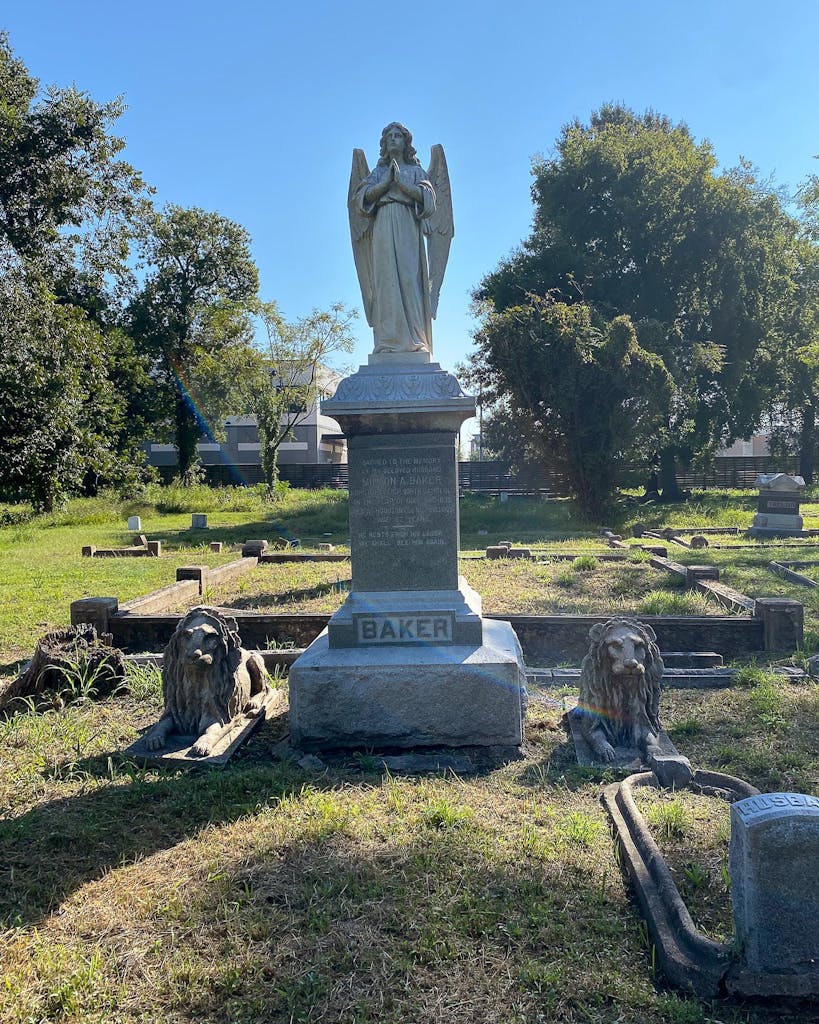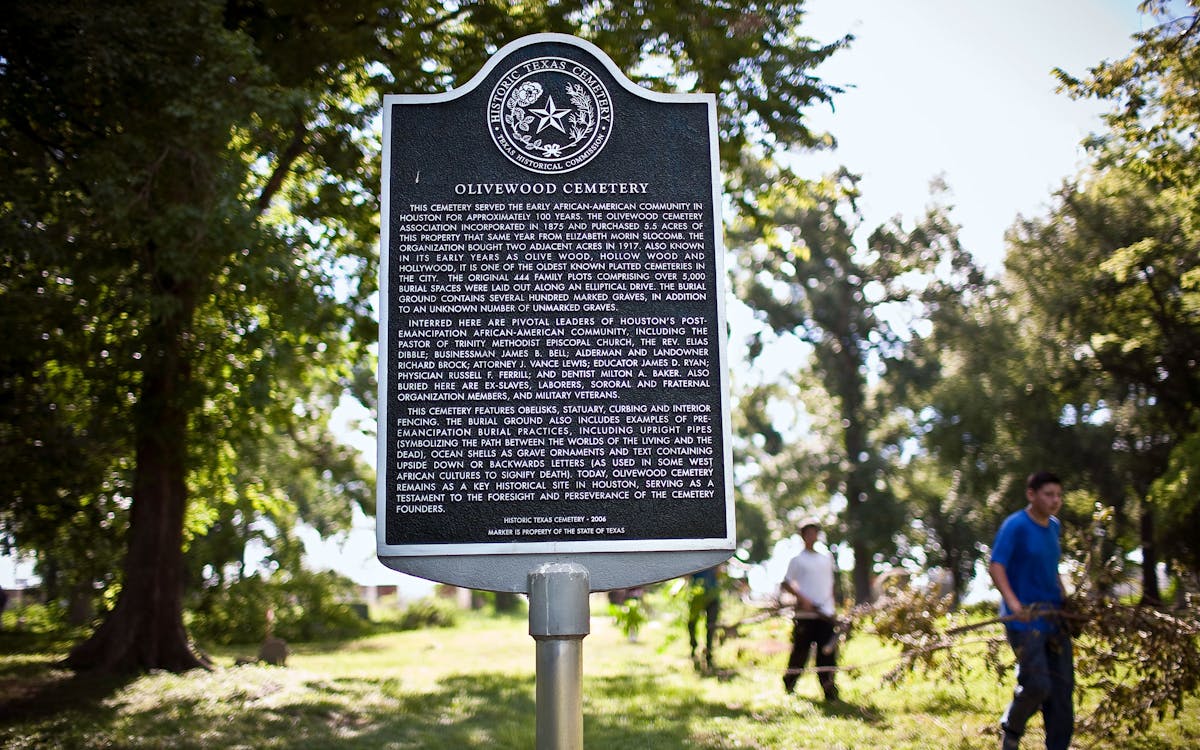[ad_1]
When Charles Cook first visited Olivewood Cemetery in 1993, he needed a machete to cut through the invasive brush that had grown there. There was no fence surrounding the property, and Cook recalls walking through a jungle-like maze to admire the statue of an angel that stands in the center of the site. The cemetery, where one of the former scout’s great-grandmothers is buried (and another could be, although he could not find the land) was made up in 1875 and is the oldest Houston Black Cemetery. For more than two decades, property near the Houston Heights neighborhood had been neglected.
When Margott Williams visited the cemetery in 1999 after the death of her grandmother, she also found the burial site in disarray. She expected a cemetery in a big city to be well maintained. The then 36-year-old woman gazed in disbelief at all the trees and vines around where her grandfather was buried. “It kept bothering me that Olivewood looked the way he looked,†says Williams.
Williams has contacted the county historical commission on the preservation of the site. A woman there urged her to start working on the upkeep of the cemetery herself. So Williams grabbed his own lawn mower and sickle and started pruning decades of overgrowth. During those lonely days of trying to put the cemetery back in good repair, Williams shed tears and had conversations with her late grandfather as she worked on the lawn. “For years I’ve been here pushing this lawn mower and doing all these things, and sometimes I just kept looking where I parked, going – nobody yet? Do this for an hour or two. Would I look around, no one again? Then you come and do it day in and day out, â€says Williams.
Cook and Williams were linked by the County Historical Commission in 2004, and are now both part of the nonprofit Descendants of Olivier, founded to preserve the heritage of their ancestors. The association obtained guardianship of the cemetery in 2008 after facing another association in court. Soon after, a new fence was erected around the cemetery, and others in the neighborhood – boy scouts, church members and businesses doing community service – joined in the clean-up days to help the couple .
Although the cemetery has been largely restored, it began to face new challenges, including flooding and rainwater runoff from commercial development in the neighborhood surrounding the cemetery. Cook and Williams want to make sure that the preservation of the site persists and doesn’t end with them. Their nonprofit organization received a $ 50,000 grant from the National Trust for Historic Preservation this summer to help improve the site.
“We will not be moved. We cannot be moved, â€Cook, who is 65, told me one day in September as we visited the site. “What if he goes back to what he looked like in 1993?” What if we don’t have a succession plan? Or we haven’t set up an endowment fund where it is supported even when we are dead and gone? “
When Cook started discussing the history of Olivewood Cemetery, where many of Houston’s black pioneers are buried, every word was filled with meaning. His voice echoed in the solemn trees that enveloped the cemetery. “I think if I bleed someone cut me, it’ll probably bleed Olivewood,†Cook said.
Incorporated in 1875, Olivewood may have been a burial place for slaves: two tombstones date from 1869 and 1871, according to the Texas State Historical Association. About four thousand Houstonians are buried at the site, including the city’s first black alderman and Emancipation Park co-founder Richard Brock; educator and community leader James D. Ryan; and Dr. Charles B. Johnson, known as “The Singing Dentist†and creator of the Houston Bicentennial song “Houston is a great old townâ€.
David Bruner, professor of anthropology at Lone Star College-CyFair in Harris County, studied the cemetery for years, and before the pandemic took his students there to study the gravestones. He says the cemetery is filled with expressions from the West African tradition: vertical metal pipes that line the graves, reverse writing on some markers, and shell patterns on the stones. He and his students helped Olivewood to be recognized by the United Nations Educational, Scientific and Cultural Organization (UNESCO) as part of the Slave Route Project, which lists the historic places that formed as a result of the African diaspora during the transatlantic slave trade.

“It is a sad state of affairs that African diaspora sites are under-documented. They are not as written or researched as other types of sites in the United States, â€explains Bruner. “This is why I designate Olivewood Cemetery as Harris County’s most important cultural resource, because it expresses this window into our knowledge of African American history in a very unique way.”
In its early days, the cemetery was a source of pride for Houston’s black community. Several Houstonians held stock in the cemetery, including Reverend David Elias Dibble, a former slave who served as the ordained black premier of Trinity Methodist Episcopal Church, according to TSHA. But in the 1940s, commercial and residential development spread throughout the neighborhood surrounding the cemetery. Companies, including a design firm and a grocery supplier, have blocked access to an alleyway used by residents to get to the site. The Olivewood Cemetery Association appealed to Mayor Oscar Holcombe to restore access in September 1950, and the City of Houston ended up selling the group near the cemetery that gave community members access to a lot. at the site, according to Cook. But over time the cemetery became neglected and burials ceased in the 1960s.
In the early 2000s, when Williams was attempting to preserve the site on her own, she asked her late grandfather, Cain Nelson Sr., for a sign. “You have to show me something. Someone has to show me something, â€Williams recalls. “God has to show me something. Because I can’t keep doing this. After several months of Williams’ lonely labor, the woman on the historical commission put Williams in touch with a city councilor who recruited probationers to come out and start cleaning up the cemetery and mowing the grass. Williams also says that a gentleman with a bush pig emptied the rest of the graveyard. Finally, she could see all the burial sites that had been covered with vegetation. “I said, ‘Look at my people. This is my family, â€says Williams.
Today, flooding and erosion problems have also ravaged the historic site. It sits right next to White Oak Bayou, which regularly invades its shores. As Cook says, “When White Oak Bayou coughed, Olivewood got the flu. Really bad. During Hurricane Harvey, the cemetery was severely flooded; Paul Jennings, a seventy-year-old man who first discovered the cemetery on a volunteer clean-up day in the 2000s, estimates parts of the cemetery were fifteen to twenty feet underwater. This summer, the cemetery withstood exceptionally rainy weather, but in September Tropical Storm Nicholas barred the site.
Some funeral plots have been permanently damaged or lost forever, and help with the preservation of Olivier has become more necessary. The $ 50,000 grant the cemetery received from the National Trust for Historic Preservation is part of the $ 3 million the group has distributed through its African American Cultural Heritage Action Fund to forty historic sites across the country in the aim to preserve black history. With the money, the Descendants of Olivier work with civil engineers to complete a survey of the area and determine a master drainage plan. The group also strives to have a strong database of the graves at the site, so that family members can locate who is buried there. Jennings also hopes the association can secure funding to repair some of the damaged monuments in the cemetery. To achieve all of this, Williams says the group will need to raise funds of at least $ 2-3 million.
Cook and Williams hope they can form partnerships with local organizations to raise funds. They have big visions for the cemetery, believing one day that it could be a park and that a museum could be built to honor local history. They plan to leave a written history of Olivier so that the story of his early years and repairs remains accessible to future generations. “It was blood, sweat and tears,†Williams says. “It has been a labor of love.”
On a sweltering September day, Cook and Williams walked through the historic park under soaring trees, stopping to view various burial sites. They pulled up to a freshly cleaned majestic monument with elegant letters to Reverend AF Jackson, who was assassinated in Dallas and buried in Olivewood in 1889. Nearby, other statues were faded or graying. The couple visited their own parents’ plots and Williams admired his family’s marker, adorned with engraved flowers. In the center of the cemetery, the angel statue that Cook admired all these years before is still standing, his face solemn and his hands in prayer position.
“If I die tomorrow I can say, ‘Dude, I did a pretty good deed while I was here,’†says Cook. “I gave my time. I gave my service to a good cause.
[ad_2]

